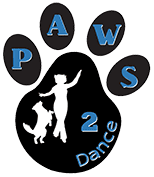 Imagine moving across the floor in time with the music, interpreting the music with your steps, body movements, and hand positions. Now, add a dog weaving between your legs, spinning in unison with you, circling you – essentially helping you tell a story with the music. That’s what canine musical freestyle is all about.
Imagine moving across the floor in time with the music, interpreting the music with your steps, body movements, and hand positions. Now, add a dog weaving between your legs, spinning in unison with you, circling you – essentially helping you tell a story with the music. That’s what canine musical freestyle is all about.
Handlers teach dogs a repertoire of movements and choreograph routines using those movements. The range of moves is limitless. Dogs can be crawling, on all fours or up on their hind legs. They can move with or apart from the handler, forward, backward, or sideways. They can spin, roll, or jump. They can do paw tricks or strike interesting poses. They can even use props. Anything goes as long as the move is not dangerous to the dog.
 In competitions, divisions range from beginner levels to master, and the dog and handler are judged equally. At each successive level, the routine is expected to have more technical difficulty and increased artistic impression.
In competitions, divisions range from beginner levels to master, and the dog and handler are judged equally. At each successive level, the routine is expected to have more technical difficulty and increased artistic impression.
But competitions are just a small part of freestyle. Somehow, a dancing dog can bring a smile to pretty much anyone’s face and freestylers are frequently asked to perform at seniors’ residences, fund-raisers, or community fairs.
